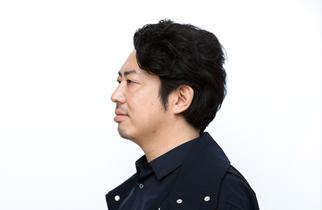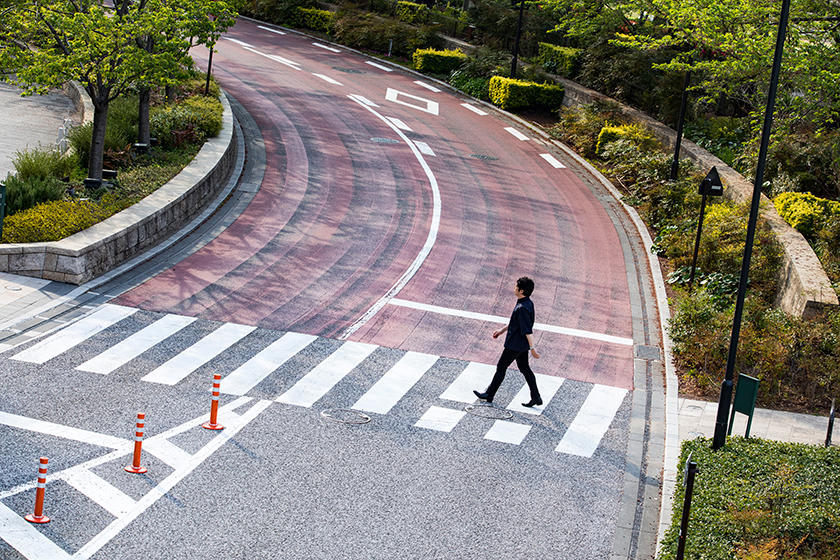
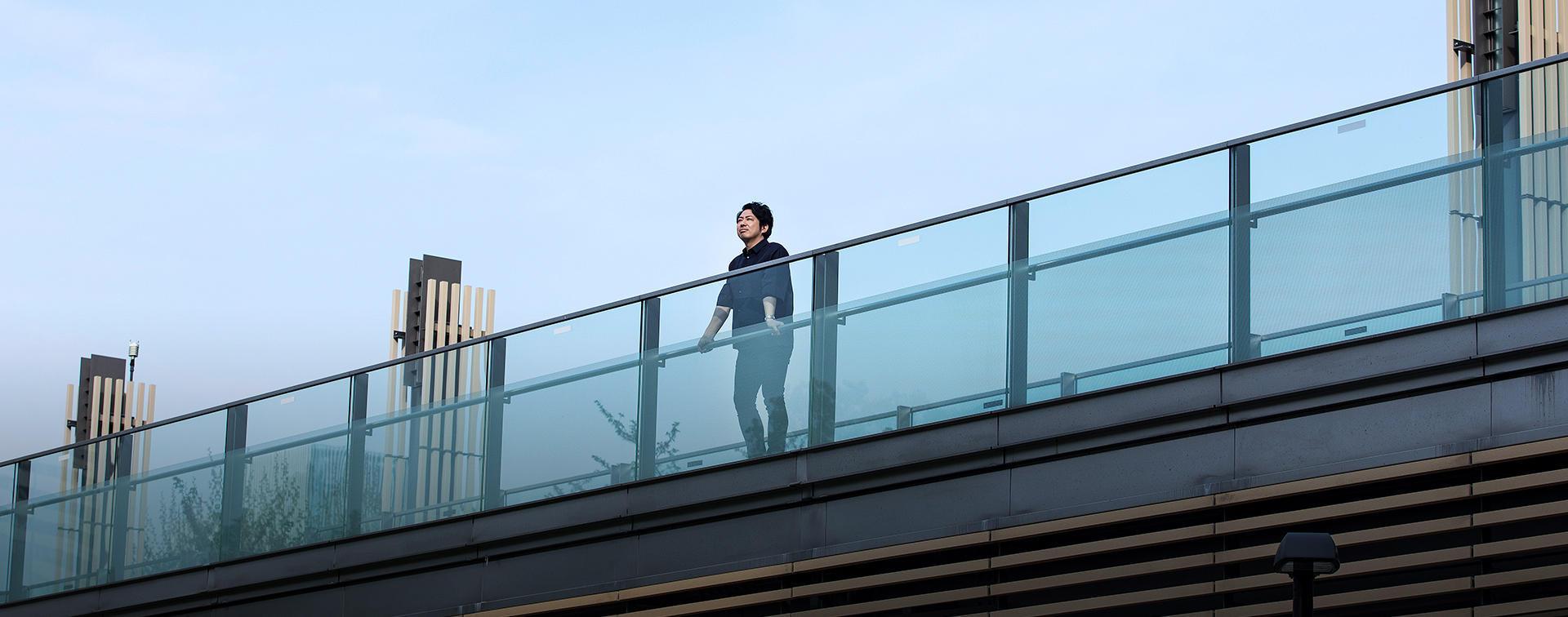
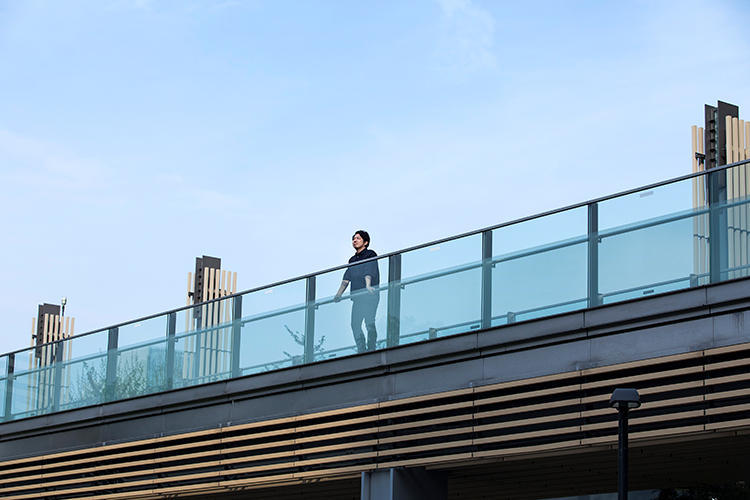
Local characteristics are the finest things
Transport that is midway between walking and bicycling will make the streets fun
In 2008, Keita Suzuki won the special jury prize at the first “TOKYO MIDTOWN AWARD” design competition for his Mt. Fuji-shaped beer glass. When it was put on the market, the Fujiyama Glass became a hit product, and Suzuki went on to design a wide range of things from soy sauce containers to train carriages. We were interested to know how he has evolved as a product designer. Suzuki, who makes it a point not to limit himself to certain genres, talked enthusiastically about the things that are important to him in design, and about what interests him these days.
The Fujiyama Glass - the first widely-recognized product I designed
You could say that my starting point was the Fujiyama Glass for which I received the special jury prize - also known as the Manabu Mizuno Prize - at the first "TOKYO MIDTOWN AWARD" design competition. I've always loved to travel, and since a student, I have traveled as a backpacker to all sorts of places around the world. At the places I visited, I would buy souvenirs to give as gifts. But almost always, when I came back to Japan and some time had passed, I would feel disappointed with them and think to myself, "Why did I buy these?" So instead of a souvenir that had no practical purpose, I had a wish to make a souvenir that could be used as an everyday item.
I wanted to make something that everybody uses at home, and I thought a glass cup which is a universal product, would be ideal. I decided to choose from three motifs; the Tokyo Tower, sumo and Mt. Fuji. Then one day, when I was drinking beer, I thought, "Maybe I could make this look like Mt. Fuji.". That inspiration immediately accelerated my ideas.
I had previously been an in-house designer at a major company, working within a big, vertically divided structure. When it was time to sell a product, the salespeople would think of a slogan, and an advertising agency would make a commercial, but the final product would often turn out to be very different from the image I had when I was designing it - there would be a big gap between the product and my initial ideas and values. For instance, I would design a minimal, simple laptop PC, aiming to make something very new, but it would be marketed as an A4-size notebook PC for female college students. (laughs)
To commercialize the Fujiyama Glass, a small team was formed, including Mizuno-san and staff at Tokyo Midtown. We made our own decisions, from picking the manufacturer to all the small details related to selling strategy and pricing. When it became a hit product, the joy and thrill of it was something I had never experienced before. It was the first time that I felt a design of my own had materialized in its purest form.
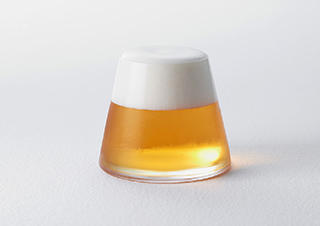
Fujiyma Glass
Keita Suzuki's best known product, it won the judge's special prize (Manabu Mizuno Prize) at the "TOKYO MIDTOWN AWARD 2008" design competition, and was placed on the market in 2010. The beer glasses are made by craftsmen at Sugahara Glassworks, a glassmaker highly reputed for handmade goods.

TOKYO MIDTOWN AWARD
A competition held every year by Tokyo Midtown consisting of the design and the art category. The competition is based on Tokyo Midtown's concept of "creating, developing JAPAN VALUE (new Japanese values, sensibilities and talent) and always sharing them with the world; it aims to create encounters between designers and artists, to support them and to hold collaborations with them. The competition marks its 12th year in 2019.
The product that made my world bigger
Ever since I was at school, I have loved to design - designing is something I am crazy about. (laughs) The Fujiyama Glass was actually slightly different from the kind of designs I had wanted to do, so when it became a commercial product, and people associated the Fujiyama Glass with my name, I was delighted and yet at the same time, there was a small part of me that felt resistance.
But the product seemed to take on a life of its own, and many people would tell me they were using it; I would also often be introduced as the person who designed Fujiyama Glass and that would spark a lively conversation. I kept having these experiences over and over, and I came to truly appreciate having a representative work. It strengthened my ties to Mizuno-san and led to the launch of the "THE" brand. I realize now that the Fujiyama Glass was the reason so many things got started.
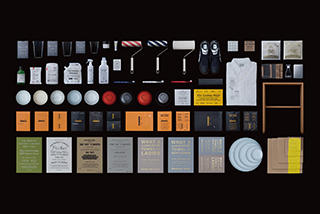
THE
A brand set up jointly by Suzuki Keita, Manabu Mizuno of good design company, and Jun Nagakawa, the 13th head of Nakagawa Masashichi Shoten. The concept of the brand is to create new standard and perennial items. Research and development is made on a wide array of products from soy sauce containers to laundry detergents.
Differences in designing for commercial products and for public things
I've designed products in various genres, and it may seem as if there's no constituency in the things I've undertaken; some people might think there's hardly any artistry in what I've done. I've always wanted to design things, regardless of genre. Rather than designers who work in one specific genre, the designers I admire are people like Sori Yanagi and Kenneth Grange, the founder of Pentagram; their expanding curiosity and interest led them to do all kinds of things.
That said, public things are totally different in nature from commercial products, and the thinking behind the design is also different. With a product like Fujiyama Glass, you can buy it if you like it, and if you don't like it, you can just ignore it. But with public things, like trains for example, you have to use them to go to work or school even if you hate their design. You can't refuse them. Public things force themselves in our everyday lives, and that's why they need to be designed very carefully. I have designed the "Series 20000" and "Series 12000" carriages for Sagami Railway; there are rules for designing train carriages which take into account the fact that small children to elderly people use the train. We have to think about designing things that are easy for everyone to use, whatever the differences in body shape and physical strength. And we have to think about designs that are pleasing to the eye. There are rules and regulations regarding what materials can be used and so on, and the numerous restrictions make it very difficult. Nonetheless, design is about ingenuity, and I enjoy thinking of solutions when faced with problems. Designing public things involves a process of continuously solving problems, but I find the work very satisfying.
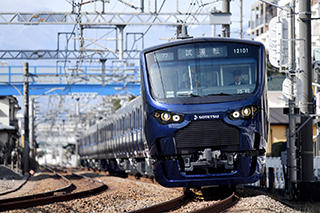
Sagami Railway's "Series 12000" train carriage
Suzuki designed the "Series 12000" following the "Series 20000" which started operations in February 2008. The concept for the train, Suzuki says, is "safe, secure and elegant." The front of the train is shaped liked the "shishiguchi" noh mask which represents a roaring mythical lion-dog. The color of the train is navy blue, symbolizing Yokohama, while the interior is in subdued grey. The "Series 12000" has already started to run on Sagami Railways, and a direct train service to Tokyo is scheduled to start on November 30, 2019.

Becoming a part of tradition through steady innovation
Whenever thinking of a new design for something that already exists, I always try to improve it. It's a commitment I've made to myself and I call it "steady innovation." In contemporary society, we have almost everything we need; our lives are overflowing with things.
I am a designer in a society that has fully matured. I create new designs because I want to make an improvement, however small, on the things that have already been invented. My desire is to make appropriate modifications in line with the times and to make things that are better than before in some way. I believe it's important to design something that will be a point of reference when a person in the next generation decides to make something new.
That's how it is when we look at history. Products are mass-produced and things are later discarded on a mass scale, but the proper things remain, and they continue to evolve as they are handed on to the next generation. That's why we have things like this now in our lives. (points to paper cup in front of him). I'm interested in the knowledge that the people before us have accumulated and I would like to respectfully follow in their footsteps. My designs are not at all flashy, and sometimes I wonder if I should do something more conspicuous. (laughs) But I am okay with doing understated designs.
I've been influenced a lot by my grandfather who was an avid collector of antiques; since I was a child, he would explain to me why each item was valuable. Listening to my grandfather and growing up surrounded by antiques, I came to understand that the things that remain have a common strength and straightforwardness. I'm now trying to apply the understanding I gained as a child to my work as a designer. The hope I always have is that what I do will become a part of the tradition carried on from generation to generation - I would like to be a dot in the long line of dots.
The characteristics of Japan - reflecting the four distinct seasons
I'm interested these days in characteristics that are unique to a locality. Once, I was on a train in India, and I saw children come to sell chai to the passengers when we stopped at a station. The chai was poured into small unglazed clay cups, and after the passengers had finished drinking, they threw the cups out of the windows. The cups were just twisted bits of clay that had been fired without glazing, so when thrown to the ground, they return to the soil. I was impressed by the clever and rational custom of avoiding the piling up of litter.
People in India have metal lunch boxes with engraved marks. Apparently this can be traced back to a system which was the basis for the caste system; the marks were needed to prevent personal belongings from being mixed up with other people's belongings. There are so many discoveries to be made when you look at the daily items used in countries around the world and you learn about the thinking behind them. When I travel, I like going to art museums and museums. It allows me to get an overall view of how the history in that locality resulted in unique things and skills; I learn a lot.
I think the defining characteristics of Japan are its four distinct seasons. The seasons are reflected in tableware; for instance, a bowl for spring is decorated with the wonders of nature during the springtime. Japan is probably about the only country where dishes, small and big, are changed according to the season. The sense of living with the exquisite, changing seasons is a fundamental sense that is deeply ingrained in the Japanese people. It is something that I would like to express and pass on in my designs.
From around the year 2,000, the trend in Japanese design and art has been for things that are simple, minimal and cute. It's a concept that has not existed in Europe, and I can understand that it seems fresh, but I've always felt that there are other aspects to the Japanese sense of beauty. There are so many things in Japan that are lovely and elegant but not necessarily simple; a good example is kabuki. I think the other aspects have not been well reflected in designs yet.
People abroad are starting to notice the unique materials and aesthetic in Japan
About two years ago, I started working periodically for a European fashion house. I once inquired why they asked me to work for them. They told me that when they come to Japan, the stones they see lying about and the paper they see us using are of the sort they haven't seen before, and that the buildings are made from a kind of wood that they haven't seen before. They said they live surrounded by leather and marble, and they wish me to introduce to them all sorts of interesting materials. In the same way that the chai cups in India fascinated me, there are still so many things in Japan that are fascinating for people in other countries.
In the European fashion world, Raku ware is very popular now. I think that since the old days, the Japanese have sensed beauty in things like Raku ware - things that are uneven and unbalanced and complicated at first glance. People abroad are beginning to realize that this aesthetic sense does not exist anywhere else in the world. We have already attracted people's interest and curiosity, so what we have to do from now on is to create new designs and new aspects of Japanese beauty that have not yet been presented. By working for a fashion house, I've come to realize that things that are unique to a locality are the finest things.
At the Milan Design Week 2019 that was held recently, I showed an installation made from glass and ceramics called "Emergence of Form." I got the impression that the ceramics were very well received. A 3D printer was used to make the molds for the roughly 180 pieces of ceramics which were placed in the exhibition venue; the pieces were dipped in specially concocted glazing and the color of each piece was subtly different. People at a big Japanese company might think that the ceramics are not of the best quality because the colors are all different, but I thought that showing simply flawless things would not impress the people in Europe. In line with my expectations, the designers I talked to said they found the complicated glazing interesting. You could say that the 20th century was an age where the goal was to make things perfectly, but now that the goal has been accomplished, we seem to be entering an age where we are moved by the imperfect things.
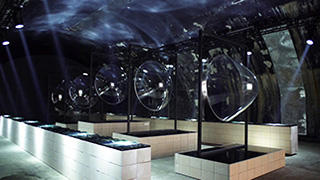
Emergence of Form
An installation made by Suzuki, who was Creation Partner this year for glassmaker AGC. The work was exhibited by AGC at Milan Design Week (April 9-14, 2019). Consisting of ceramics and glass, and taking advantage of AGC's latest molding technology, the installation expresses the beauty of the changing seasons. It was exhibited at Milano Centrale train station, in a space beneath the elevated railway tracks.
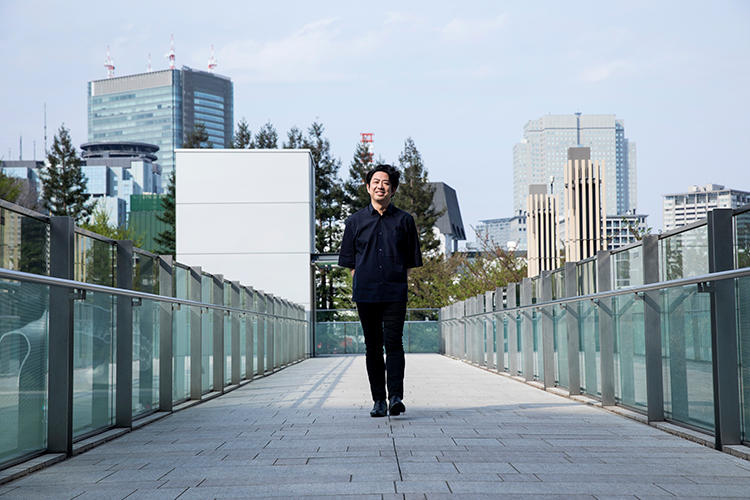
Genuine culture that is born spontaneously from open spaces
Having done work for railways, I have an interest in creating a unique form of transport for Tokyo. In Paris, the landmarks are all connected and the city as a whole looks lovely, but in Tokyo, development has been made in separate spots and the landmarks are scattered about. This is particularly evident in Roppongi: the distance between Roppongi Hills and Tokyo Midtown is a bit too far and doesn't encourage people to walk back and forth between them, and it's bothersome to use the Oedo subway station which is so deep underground. So it would be nice if there was another form of transport - something that is midway between walking and bicycling that allows people to move about the streets more easily.
In Paris and Milan, there are electric kickboards everywhere that you can rent; they are used not only by the tourists but also quite frequently by the locals. I've rented them several times. It is fun riding them because your perspective changes and you can see the city in a new way; you can move about easily, wandering into narrow alleys. Perhaps it would be a good idea to offer some form of transport during events in Roppongi such as Roppongi Art Night.
I think what the streets of Tokyo lack are spaces where people can do anything they like. That's why there's not much sense of freedom. The grass square in Tokyo Midtown is very valuable because of the empty space. In the great cities of other countries, it's usual to see people eating lunch outside or lying on the ground. I like black music and hip hop; I think that culture born spontaneously from mundane places such as the streets is a culture that is genuine and one that has backbone. I'm certain that places where people can spend time freely will bring richness to a city, leading to good works in genres like art and design. And there will probably be local characteristics; for instance, there will be differences between Shibuya, Roppongi and Asakusa in the culture that comes from empty spaces.
Obviously, if we try to make things that exist in any country, we end up with uninteresting things that have no individuality. The reason foreigners are swarming Kyoto is that they can experience things there that are absolutely unique to the locality. In Tokyo, particularly in places like Shibuya, bars and alleys are being demolished; cultures that spontaneously sprung up after the World War II, and that have developed over many years are being destroyed in the blink of an eye. And they are trying to create things that only have the look of newness. It's such a pity. The defining characteristic of Roppongi is that it has many art museums. Maybe its other characteristic is that there are bad people (laughs). Streets, and anything else for that matter, are interesting when they have the dual aspects of Yin and Yang. A place that is spotless might make people feel safe, but it isn't beguiling. The Yin aspect certainly exits in Roppongi, and I find it an attractive place.
Thinking in Bhutan about the relationship between people and things
From the perspective of local characteristics, Bhutan is the most fascinating place for me. I've been there many times for a social contribution project I'm involved in. Bhutan is located at the foot of the Himalayas, so the roads there are basically all mountain roads. There are no expressways or trains, and there are few people who own cars. But precisely because the transport infrastructure is undeveloped, Bhutan has extremely primitive handcraft which most people don't know about.
The tools that the residents of Bhutan use in their daily lives are the kind that people in developed countries have seen only in monochrome illustrations. There are people who make fragile-looking dishes every day: the dishes look as if they would break if they were used just once. We tend to seek things that have permanence or things that are complicated, but each time I go to Bhutan, I get the feeling that it might be better for us to have a more simple relationship with things. The way the people in Bhutan live - making things only from materials that are found locally - is devoid of strain; their way of living has a very different meaning from the concept of sustainability being advocated in the developed countries.
What I ultimately find attractive are the local characteristics. The lifestyle and the culture that are born from a certain region are unattainable for those who don't live there. That is why I think the local characteristics are the finest things. As for how they can be used in designs ... I will have to think about that. (laughs)
Editor's thoughts
Since childhood, Keita Suzuki-san has developed an eye for beauty, seeing antiques and visiting art museums in Japan and abroad. While Suzuki-san must have seen so many lovely things, it was remarkable how excitedly he talked about the daily items he saw in India and Bhutan. On hearing him say that the local characteristics are the finest things, I felt as if scales had fallen from my eyes. It was like gaining a new perspective - just like riding a kickboard for the first time. (text_ikuko hyodo)(text_ikuko hyodo)




